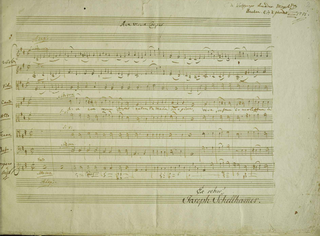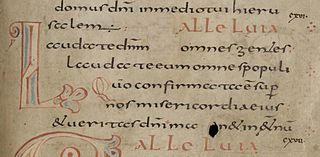Related Research Articles

William Byrd was an English Renaissance composer. Considered among the greatest composers of the Renaissance, he had a profound influence on composers both from his native country and on the Continent. He is often considered along with John Dunstaple and Henry Purcell as one of England's most important composers of early music.

The Hail Mary or Angelical salutation is a traditional Catholic prayer addressing Mary, the mother of Jesus. The prayer is based on two biblical passages featured in the Gospel of Luke: the Angel Gabriel's visit to Mary and Mary's subsequent visit to Elisabeth, the mother of John the Baptist. It is also called the Angelical Salutation, as the prayer is based on the Archangel Gabriel's words to Mary. The Hail Mary is a prayer of praise for and of petition to Mary, regarded as the Theotokos. Since the 16th century, the version of the prayer used in the Catholic Church closes with an appeal for her intercession. The prayer takes different forms in various traditions and has often been set to music.

Miserere is a setting of Psalm 51 by Italian composer Gregorio Allegri. It was composed during the reign of Pope Urban VIII, probably during the 1630s, for the exclusive use of the Sistine Chapel during the Tenebrae services of Holy Week, and its mystique was increased by unwritten performance traditions and ornamentation. It is written for two choirs, of five and four voices respectively, singing alternately and joining to sing the ending in one of the most recognised and enduring examples of polyphony, in this case in a 9-part rendition.
A false relation is the name of a type of dissonance that sometimes occurs in polyphonic music, most commonly in vocal music of the Renaissance and particularly in English music into the eighteenth century. The term describes a "chromatic contradiction" between two notes sounding simultaneously in two different voices or parts; or alternatively, in music written before 1600, the occurrence of a tritone between two notes of adjacent chords.

O magnum mysterium is a responsorial chant from the Matins of Christmas.
"O Salutaris Hostia" is a section of one of the Eucharistic hymns written by Thomas Aquinas for the Feast of Corpus Christi. He wrote it for the Hour of Lauds in the Divine Office. It is actually the last two stanzas of the hymn Verbum supernum prodiens, and is used for the Adoration of the Blessed Sacrament. The other two hymns written by Aquinas for the Feast contain the famous sections Panis angelicus and Tantum ergo.
Sven Fredrik Johannes Sixten is a Swedish composer, cathedral organist and conductor. Sixten was born in Skövde, Sweden. He earned his Bachelor of Arts (1986) at the Royal College of Music, Stockholm. He studied composition with Professor Sven-David Sandström and is now recognized as one of Sweden's best-known composers of church music. He is published at all major publishing houses in Sweden.

Colin Mawby KSG was an English organist, choral conductor and composer. From 1961 he was Master of Music at Westminster Cathedral, then from 1981 he was the choral director at Radio Telefís Éireann. He composed masses dedicated to specific choirs, including in Germany. He was awarded Knighthood of the Order of St. Gregory in 2006.

The St Luke Passion is a work for chorus and orchestra written in 1966 by Polish composer Krzysztof Penderecki. He composed the work to commemorate a millennium of Polish Christianity following the baptism and conversion of Polish duke Mieszko I in 966 AD. Penderecki's setting is one of several musical settings of the Passion story and contains text from the Gospel of Luke as well as other sources such as the Stabat Mater. Despite the Passion's almost total atonality and use of avant-garde musical techniques, the musical public appreciated the work's stark power and direct emotional impact and the piece was performed several more times soon after its premiere on 30 March 1966.
"Pie Jesu" is a text from the final (nineteenth) couplet of the hymn "Dies irae", and is often included in musical settings of the Requiem Mass as a motet. The phrase means "pious Jesus" in the vocative.
Imant Karlis Raminsh is a Canadian composer of Latvian descent, best known for his choral compositions. He resides in Coldstream, British Columbia.
The Orchestral Suite No. 4, Mozartiana, Op. 61, is an orchestral suite by Pyotr Ilyich Tchaikovsky, written in 1887 as a tribute to Wolfgang Amadeus Mozart on the 100th anniversary of that composer's opera Don Giovanni. Because this suite consists of four orchestrations of piano pieces by Mozart, Tchaikovsky did not number this suite with his previous three suites for orchestra. Instead, he considered it a separate work entitled Mozartiana. Nevertheless, it is usually counted as No. 4 of his orchestral suites.

Catholic Marian music shares a trait with some other forms of Christian music in adding another emotional dimension to the process of veneration and in being used in various Marian ceremonies and feasts. Marian music is now an inherent element in many aspects of the veneration of the Blessed Virgin Mary in Catholic Mariology.

Frank La Rocca is an American classical music composer.

Ave verum corpus, , is a motet in D major composed by Wolfgang Amadeus Mozart in 1791. It is a setting of the Latin hymn of the same name. Mozart wrote it for Anton Stoll, a friend who was the church musician of St. Stephan in Baden bei Wien. The motet was composed for the feast of Corpus Christi; the autograph is dated 17 June 1791. It is scored for SATB choir, string instruments and organ.

Psalm 117 is the 117th psalm of the Book of Psalms, beginning in English in the King James Version: "O praise the LORD, all ye nations: praise him, all ye people." In Latin, it is known as Laudate Dominum. Consisting of only two verses, Psalm 117 is the shortest psalm and also the shortest chapter in the whole Bible. It is joined with Psalm 118 in the manuscripts of the Hebraist scholars Benjamin Kennicott and Giovanni Bernardo De Rossi.

Mozart: Grosse Messe c-moll KV 427 is an 86-minute live video album of Wolfgang Amadeus Mozart's Christian vocal works Great Mass in C minor, Ave verum corpus and Exsultate, jubilate, performed by Arleen Auger, Cornelius Hauptmann, Frank Lopardo, Frederica von Stade, the Bavarian Radio Symphony Chorus and the Bavarian Radio Symphony Orchestra under the direction of Leonard Bernstein. Deutsche Grammophon issued it on VHS video cassette, Laserdisc and DVD, and also released audio cassette and CD versions of its soundtrack.
Gregoire was a composer.
References
- ↑ Rubin, Miri (1992). Corpus Christi: The Eucharist in Late Medieval Culture. Cambridge University Press. p. 56.
- ↑ Heartz, Daniel (2009). Mozart, Haydn and Early Beethoven: 1781–1802. New York: W. W. Norton & Co. p. 351.
- ↑ Imant Raminsh: "Ave Verum Corpus" on YouTube
- ↑ Malcolm Archer: "Ave Verum" on YouTube
- ↑ Jack Gibbons" "Ave Verum Corpus", Op. 90 on YouTube
- ↑ Fredrik Sixten: "Ave Verum Corpus" on YouTube
- ↑ Philip Stopford: "Ave Verum" on YouTube
- Ave verum corpus natum. The Canterbury Dictionary of Hymnology. Canterbury Press (2013).
- Guido Maria Dreves: Analecta Hymnica Medii Aevi (1886), 54.257.
